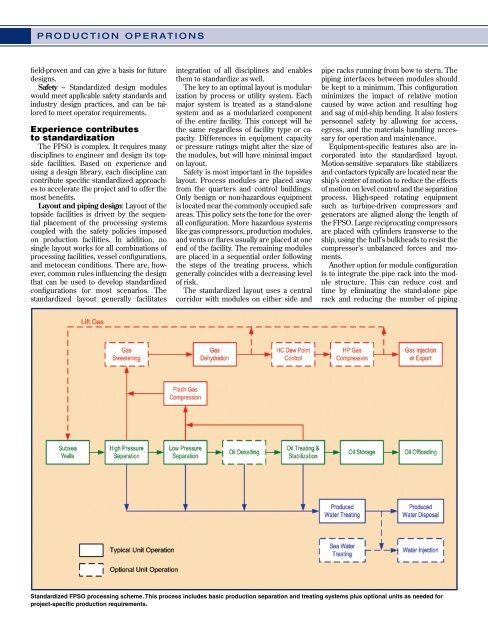Standardization adds value to FPSO topsides - Alliance Wood ...
Standardization adds value to FPSO topsides - Alliance Wood ...
Standardization adds value to FPSO topsides - Alliance Wood ...
You also want an ePaper? Increase the reach of your titles
YUMPU automatically turns print PDFs into web optimized ePapers that Google loves.
production operations<br />
field-proven and can give a basis for future<br />
designs.<br />
Safety – Standardized design modules<br />
would meet applicable safety standards and<br />
industry design practices, and can be tailored<br />
<strong>to</strong> meet opera<strong>to</strong>r requirements.<br />
Experience contributes<br />
<strong>to</strong> standardization<br />
The <strong>FPSO</strong> is complex. It requires many<br />
disciplines <strong>to</strong> engineer and design its <strong>to</strong>pside<br />
facilities. Based on experience and<br />
using a design library, each discipline can<br />
contribute specific standardized approaches<br />
<strong>to</strong> accelerate the project and <strong>to</strong> offer the<br />
most benefits.<br />
Layout and piping design: Layout of the<br />
<strong>to</strong>pside facilities is driven by the sequential<br />
placement of the processing systems<br />
coupled with the safety policies imposed<br />
on production facilities. In addition, no<br />
single layout works for all combinations of<br />
processing facilities, vessel configurations,<br />
and me<strong>to</strong>cean conditions. There are, however,<br />
common rules influencing the design<br />
that can be used <strong>to</strong> develop standardized<br />
configurations for most scenarios. The<br />
standardized layout generally facilitates<br />
integration of all disciplines and enables<br />
them <strong>to</strong> standardize as well.<br />
The key <strong>to</strong> an optimal layout is modularization<br />
by process or utility system. Each<br />
major system is treated as a stand-alone<br />
system and as a modularized component<br />
of the entire facility. This concept will be<br />
the same regardless of facility type or capacity.<br />
Differences in equipment capacity<br />
or pressure ratings might alter the size of<br />
the modules, but will have minimal impact<br />
on layout.<br />
Safety is most important in the <strong>to</strong>psides<br />
layout. Process modules are placed away<br />
from the quarters and control buildings.<br />
Only benign or non-hazardous equipment<br />
is located near the commonly occupied safe<br />
areas. This policy sets the <strong>to</strong>ne for the overall<br />
configuration. More hazardous systems<br />
like gas compressors, production modules,<br />
and vents or flares usually are placed at one<br />
end of the facility. The remaining modules<br />
are placed in a sequential order following<br />
the steps of the treating process, which<br />
generally coincides with a decreasing level<br />
of risk.<br />
The standardized layout uses a central<br />
corridor with modules on either side and<br />
pipe racks running from bow <strong>to</strong> stern. The<br />
piping interfaces between modules should<br />
be kept <strong>to</strong> a minimum. This configuration<br />
minimizes the impact of relative motion<br />
caused by wave action and resulting hog<br />
and sag of mid-ship bending. It also fosters<br />
personnel safety by allowing for access,<br />
egress, and the materials handling necessary<br />
for operation and maintenance.<br />
Equipment-specific features also are incorporated<br />
in<strong>to</strong> the standardized layout.<br />
Motion-sensitive separa<strong>to</strong>rs like stabilizers<br />
and contac<strong>to</strong>rs typically are located near the<br />
ship’s center of motion <strong>to</strong> reduce the effects<br />
of motion on level control and the separation<br />
process. High-speed rotating equipment<br />
such as turbine-driven compressors and<br />
genera<strong>to</strong>rs are aligned along the length of<br />
the <strong>FPSO</strong>. Large reciprocating compressors<br />
are placed with cylinders transverse <strong>to</strong> the<br />
ship, using the hull’s bulkheads <strong>to</strong> resist the<br />
compressor’s unbalanced forces and moments.<br />
Another option for module configuration<br />
is <strong>to</strong> integrate the pipe rack in<strong>to</strong> the module<br />
structure. This can reduce cost and<br />
time by eliminating the stand-alone pipe<br />
rack and reducing the number of piping<br />
Standardized <strong>FPSO</strong> processing scheme. This process includes basic production separation and treating systems plus optional units as needed for<br />
project-specific production requirements.


